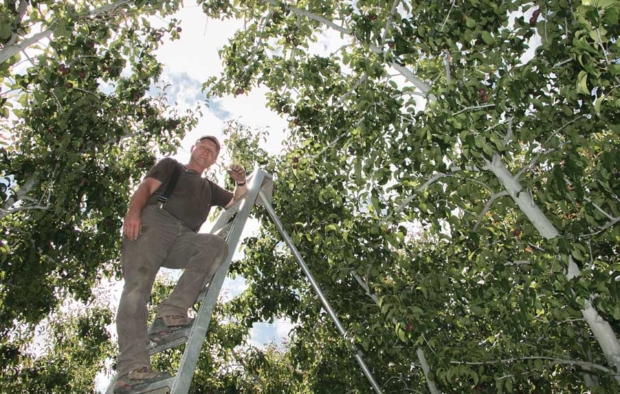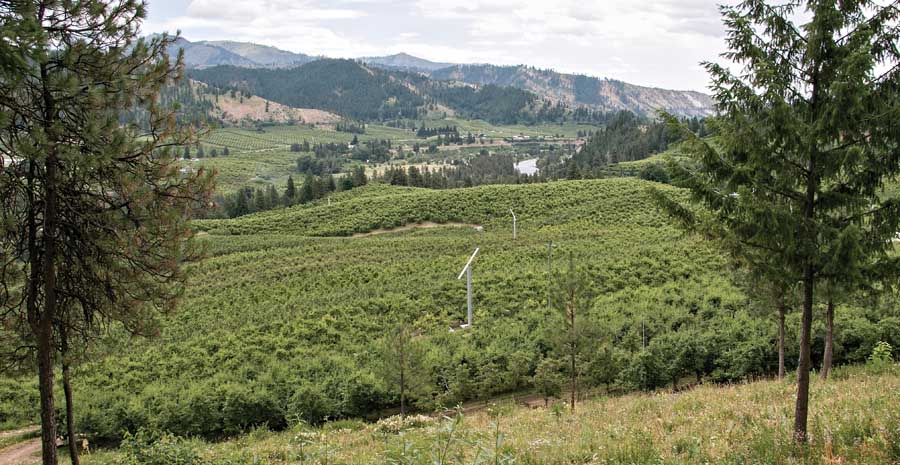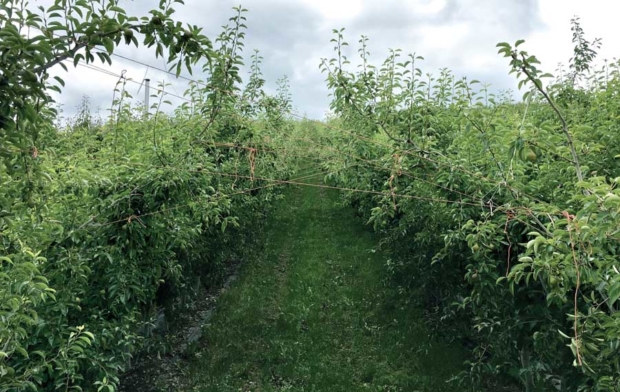
Rudy Prey of Leavenworth, Washington, does things with his pear trees that not all, or even most growers, do.
He ties the top branches together to pull them into an archway to maximize light exposure. He plants them close together to create high density block and starts cropping them two or three years earlier than most normally would.
“He’s wholeheartedly taken on the high density, which is difficult everywhere on earth,” said Tim Smith, the semi-retired Washington State University extension educator for Chelan County.
Prey carves his blocks from the side of a steep hill and protects them from wildfire by clearing the undergrowth of his wooded property that abuts the Wenatchee National Forest. The chore helps keep his 12 full-time employees busy all year.
He even has to shoo away a few bears occasionally, though when they visit, they usually snack on his fruit at night and are long gone by the time his workers arrive.
“He’s adapted to his circumstances,” Smith said.

Prey borrowed many of his ideas from the apple industry and applied them to pears, which, unlike apples, lack the true dwarfing rootstocks that allow growers to keep orchards compact. Researchers are trying to develop such rootstocks with little luck so far.
Prey didn’t want to wait. “I’ve been doing this for 30 years, and that hasn’t happened yet. I doubt it will in my lifetime,” said Prey, 51. “These are the rootstocks we have, and I just make them work.”
He and his father first planted in 1975 with 20-by-10-foot spacing, which raised a few eyebrows among their neighbors used to 20-by-20 or 24-by-24. With each new block, they tightened more and more, getting earlier production and higher yields. His father went as tight as 14-by-6.
Prey continued the trend when he took over management in 1996, maxing out at 14-by-1.5 feet, about 2,000 trees per acre.
Since then, he has settled on 14-by-2 or 14-by-2.5 because he noticed little improvement any tighter than that.
The steep topography of the Wenatchee River Valley between Leavenworth and Cashmere, where roughly 85 percent of the Wenatchee district’s pears are grown, prevents him from narrowing his rows any more.
Planting trees close together forces them to compete for nutrients, water and sunlight, holding back vigor and prompting more fruit. To even out sun exposure to the entire tree, he trains limbs by tying the tops together, creating a shaded archway over each alley.
“Any sunlight that hits the ground is wasted sunlight,” he said.

The leaders wind up being about the same angle as his orchard ladders come harvest time. They might even lend themselves to platforms or other mechanical equipment if he chooses to try it.
He’s hoping for a platform with tracks, again because his hills might be too steep for conventional wheels.
He tried trellising in the past but abandoned it. Pear trees have deep and strong enough roots on their own, especially in his clumpy soil.
One tree gets pulled left, the other right. He tried planting at angles but snow crushed his baby trees. At 1,700 feet in the Cascades, Leavenworth averages 22 inches a year.
“We do a lot of things up here differently because of snow,” he said.
He ran a test not too long ago, pruning his new orchard systems twice as fast as his traditional trees, some 50 years old. He estimates his newer blocks cut his costs by $50 per bin.
Most of his employees live year-round at the farm, though he does hire some seasonal harvesters.
He grows only pears on his 75-acre orchard now, two-thirds of them organic, and delivers to Peshastin Hi-Up, a few miles down the valley. He’s removed all his apples, which thrive on the flatlands of the Columbia Basin where pears can’t.
He’s happy with his conversions and innovation, discussing them openly at winter workshops. But he warned other growers to think hard before they try it.
“High density is not for everybody,” he said. Growers must commit to many changes in habits and equipment and be willing to do it over a large area to see any results. “You got to have a different mindset,” he said. •






Leave A Comment